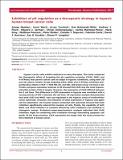Files in this item
Inhibition of pH regulation as a therapeutic strategy in hypoxic human breast cancer cells
Item metadata
| dc.contributor.author | Meehan, James | |
| dc.contributor.author | Ward, Carol | |
| dc.contributor.author | Turnbull, Arran | |
| dc.contributor.author | Bukowski-Wills, Jimi | |
| dc.contributor.author | Finch, Andrew | |
| dc.contributor.author | Jarman, Edward J. | |
| dc.contributor.author | Xintaropoulou, Chrysi | |
| dc.contributor.author | Martinez-Perez, Carlos | |
| dc.contributor.author | Gray, Mark | |
| dc.contributor.author | Pearson, Matthew | |
| dc.contributor.author | Mullen, Peter | |
| dc.contributor.author | Supuran, Claudia T. | |
| dc.contributor.author | Carta, Fabrizio | |
| dc.contributor.author | Harrison, David James | |
| dc.contributor.author | Kunkler, Ian H. | |
| dc.contributor.author | Langdon, Simon | |
| dc.date.accessioned | 2017-04-21T10:30:16Z | |
| dc.date.available | 2017-04-21T10:30:16Z | |
| dc.date.issued | 2017 | |
| dc.identifier | 249397341 | |
| dc.identifier | 7882e747-077c-4965-8910-51e0523a365e | |
| dc.identifier | 85021273991 | |
| dc.identifier | 000405493400090 | |
| dc.identifier.citation | Meehan , J , Ward , C , Turnbull , A , Bukowski-Wills , J , Finch , A , Jarman , E J , Xintaropoulou , C , Martinez-Perez , C , Gray , M , Pearson , M , Mullen , P , Supuran , C T , Carta , F , Harrison , D J , Kunkler , I H & Langdon , S 2017 , ' Inhibition of pH regulation as a therapeutic strategy in hypoxic human breast cancer cells ' , Oncotarget , vol. 8 , no. 26 , pp. 42857-42875 . https://doi.org/10.18632/oncotarget.17143 | en |
| dc.identifier.issn | 1949-2553 | |
| dc.identifier.other | ORCID: /0000-0001-9041-9988/work/64034235 | |
| dc.identifier.other | ORCID: /0000-0002-0841-609X/work/157141019 | |
| dc.identifier.uri | https://hdl.handle.net/10023/10638 | |
| dc.description | The following organizations are gratefully acknowledged: University of Edinburgh (JM), Medical Research Council (EJJ), EPSRC IMPACT (CW), Medical Research Scotland (CX) and Scottish Universities Life Sciences Alliance (CMP). This research was financed in part by a Grant of the 7th Framework Program of the European Union (METOXIA project; HEALTH-F2-2009-222741), along with the Breast Cancer Institute (BCI) and Aitken Breast Cancer Research Fund. | en |
| dc.description.abstract | Hypoxic cancer cells exhibit resistance to many therapies. This study compared the therapeutic effect of targeting the pH regulatory proteins (CAIX, NHE1 and V-ATPase) that permit cancer cells to adapt to hypoxic conditions, using both 2D and 3D culture models. Drugs targeting CAIX, NHE1 and V-ATPase exhibited anti-proliferative effects in MCF-7, MDA-MB-231 and HBL-100 breast cancer cell lines in 2D. Protein and gene expression analysis in 2D showed that CAIX was the most hypoxia-inducible protein of the 3 targets. However, the expression of CAIX differed between the 3 cell lines. This difference in CAIX expression in hypoxia was consistent with a varying activity of FIH-1 between the cell lines. 3D expression analysis demonstrated that both CAIX and NHE1 were up-regulated in the hypoxic areas of multicellular tumor spheroids. However, the induction of CAIX expression in hypoxia was again cell line dependent. 3D invasion assays conducted with spheroids showed that CAIX inhibition significantly reduced the invasion of cells. Finally, the capability of both NHE1 and CAIX inhibitors to combine effectively with irradiation was exhibited in clonogenic assays. Proteomic-mass-spectrometric analysis indicated that CAIX inhibition might be combining with irradiation through stimulating apoptotic cell death. Of the three proteins, CAIX represents the target with the most promise for the treatment of breast cancer. | |
| dc.format.extent | 9308932 | |
| dc.language.iso | eng | |
| dc.relation.ispartof | Oncotarget | en |
| dc.subject | Carbonic anhydrase IX | en |
| dc.subject | NHE1 | en |
| dc.subject | V-ATPase | en |
| dc.subject | Breast cancer | en |
| dc.subject | Hypoxia | en |
| dc.subject | RC0254 Neoplasms. Tumors. Oncology (including Cancer) | en |
| dc.subject | RM Therapeutics. Pharmacology | en |
| dc.subject | NDAS | en |
| dc.subject | SDG 3 - Good Health and Well-being | en |
| dc.subject.lcc | RC0254 | en |
| dc.subject.lcc | RM | en |
| dc.title | Inhibition of pH regulation as a therapeutic strategy in hypoxic human breast cancer cells | en |
| dc.type | Journal article | en |
| dc.contributor.institution | University of St Andrews. School of Medicine | en |
| dc.contributor.institution | University of St Andrews. Cellular Medicine Division | en |
| dc.identifier.doi | https://doi.org/10.18632/oncotarget.17143 | |
| dc.description.status | Peer reviewed | en |
| dc.date.embargoedUntil | 2017-04-17 |
This item appears in the following Collection(s)
Items in the St Andrews Research Repository are protected by copyright, with all rights reserved, unless otherwise indicated.

